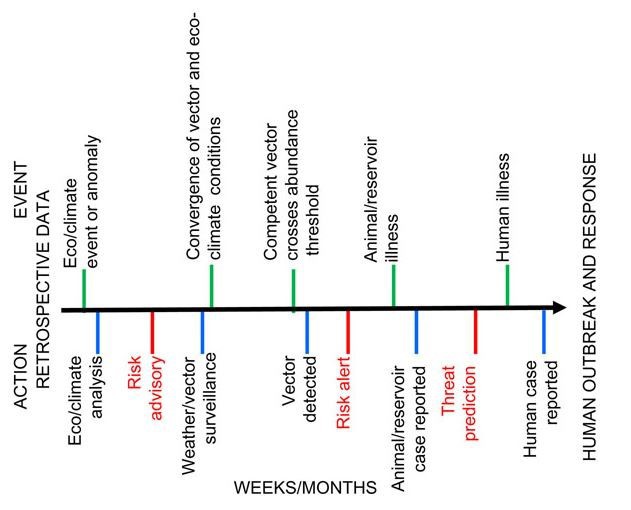Effective disease-management activities need accurate prediction of disease occurrences. The timely prediction of disease outbreaks facilitates the effective coordination and mobilization of medical, human, and pharmaceutical resources. Prior knowledge of potential disease occurrences enables proactive development of medical interventions, medical prophylaxis to disease hazards, and containment of disease vectors. This is true for both civilian public health coordination and for the military. Infectious diseases are a significant threat to the armed forces and prior knowledge of disease threats will enable the military to not only plan effective mitigation and containment strategies, but also plan the military engagement timing based on these factors. Traditional epidemiology has focused on compartmental models (susceptibility, exposed, infected, recovered (SEIR) based approaches for forecasting disease progression) [Hethcote 2000; Tebbens et. al., 2005; Mayer, 2013]. There is a need to develop occurrence prediction capabilities for novel, emerging, and re-emerging diseases.
The effective prediction of disease occurrence relies upon the collection and curation of quantitative as well as qualitative data related to historical disease occurrences, weather and environmental data, and vector data:

Need For Integrating Environmental, Vector, Animal and Human Illness Indicators for Effective Predictive Models [http://www.biomedcentral.com/1471-2458/11/S2/S10]
Natural language processing can be used to extract specific disease, syndromic, and zoonotic details from news feeds, public health reports, and medical publications. Any information related to vector presence, quantities, and virulence will benefit our disease prediction and analysis capability.
The Data Integration and Predictive Analysis System (IPAS) will enable prediction, analysis, and response management of incidents of human infectious diseases. IPAS collects and integrates comprehensive datasets of previous disease incidents and potential influencing factors to facilitate multivariate, predictive analysis such as:
- Environmental
- Vector prevalence
- Demographic
- Health conditions
- Other disease prevalence
- Trade and travel patterns
- Social media
- News feed signal patterns
- Smartphone-based sentinel data
IPAS provides comprehensive analytical support for different stages of epidemiological analysis – exploratory, spatial and temporal correlation, hypothesis testing, prediction, and intervention analysis. Innovative machine learning and predictive analytical techniques are used to predict the disease epidemic curves based on detected patterns and influencing factors. Innovative natural language processing techniques and KBSI’s Intelligence Products Mosaic™ (IPM™) tool are used to extract specific disease incidents, syndromic, and zoonotic details from news sources and medical publications and to automate the generation of disease biosurveillance reports. IPAS also supports the analysis of intervention and prophylaxis response planning in terms of human and medical resource requirements based on the predicted disease epi curve.
Benefits:
IPAS will provide a robust and easy to use framework for predicting infectious diseases. This will benefit TATRC, JPEO-CBD, and the military and civilian health systems. The timely prediction of disease outbreaks will facilitate the effective coordination and mobilization of medical, human, and pharmaceutical resources. Prior knowledge of disease incidents will enable proactive steps such as the development of medical interventions, medical prophylaxis to disease hazards, and containment of disease vectors. These features will benefit CDC, USAID, NIH, public health officials, epidemiologists, healthcare centers, and medical researchers who can mobilize resources and develop plans and contingencies to respond to global and local disease outbreaks. Other benefits of the proposed effort are:
- Comprehensive collection of diseases, environmental, cultural, demographic, zoonotic, and veterinary indicators, vector prevalence data from government agencies, medical community, news reporters, weather agencies, and public.
- Data collection, aggregation, cleaning, harmonization, pre-processing, and influencing factor analysis infrastructure.
